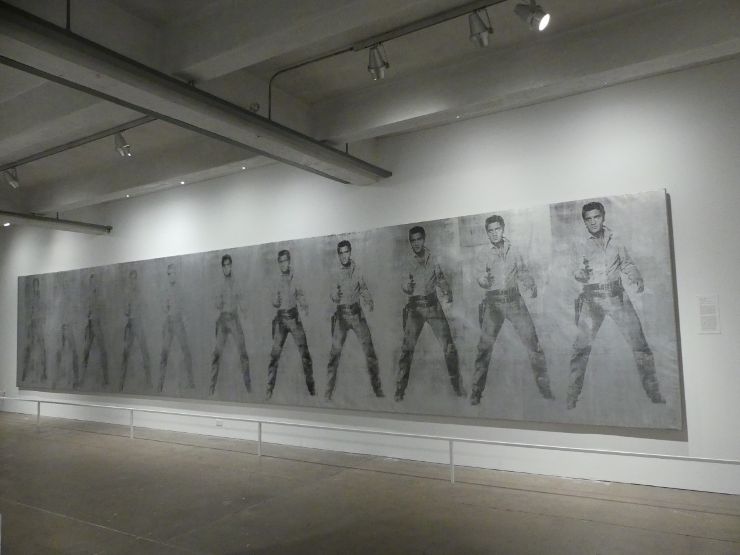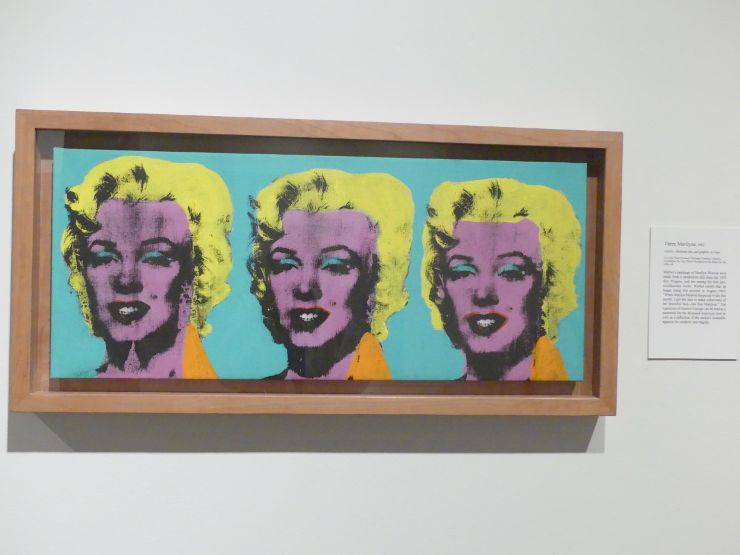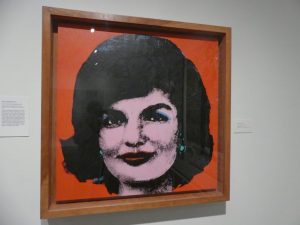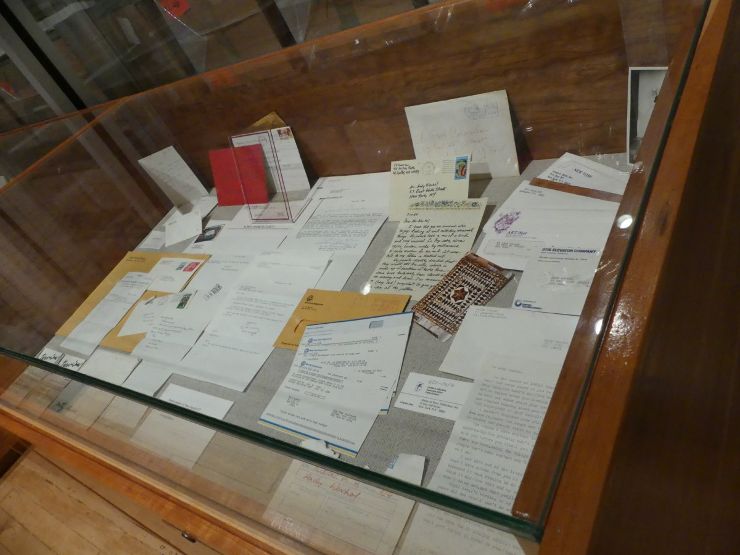Article by Kathleen Walls
During a recent visit to the Andy Warhol’s home town of Pittsburgh, I visited his museum. His artwork often focused on people and times that were familiar to me. His Elvis, Elizabeth Taylor, Jacky Kennedy and Nixon portraits chronicled America’s larger than life figures of the mid 20th century when I was growing up.
When you step into the lobby, there is a live camcorder of his grave here in Pittsburgh. Fans still bring some unusual objects to his grave. Of course, there are many Campbell’s Soup cans.

The museum is arranged from top to bottom. All but the second floor, which is a changing exhibit with different Special Exhibitions shown throughout the year, tell about Andy Warhol, the artist and the person.
After my introduction to Andy Warhol on the ground floor, I began my visit on the seventh floor, 1920s–1960s eras. That floor tells the story of a young Andy Warhol, childhood pictures of him, images of his mother, and memorabilia depicting life for a shy sickly boy in steel mill era Pittsburgh.
There’s a scrapbook of his favorite movie stars. One Shirley temple autographed picture is so indicative of the era both of these very different stars were born into. Andy was born on August 6, 1928 in the midst of the Great Depression. That probably accounted for his tremendous work ethic, drive to succeed, love of money, and commercial success. This floor carries through his college work and his beginnings doing commercial art which was probably a big influence leading into his pre-Pop Art for which he is most famous.
The sixth floor is about the 1960s, the era to which Andy Warhol is most fitted. I admired the well known pictures of Elvis 11 Times showing Elvis Presley looking as if he had just stepped off the set of Flaming Star.


I also saw the painting of Marilyn Monroe, Jackie Kennedy, and the other celebrities that so impressed Warhol. The Campbell’s Soup cans are also features here. The silk-screening work which Andy used extensively in this stage of his work is found here as well.

The part of Andy Warhol I hadn’t realized shows up here too. He created Exploding Plastic Inevitable. This was the preview of today’s rock shows with their light and sound effects. He was creative in screen and video projects. The exhibit tell how he produced The Velvet Underground and Nico’s first album which garnered little to no notice at the time but has since become one of the most influential and critically acclaimed rock albums in history, predicting the rise of Punk Rock. It is named “number 13” on Rolling Stone Magazine’s list of the 500 Greatest Albums of All Time.
Andy also produced more than 60 films from 1963 and 1968. There’s an interactive Screen Test Machine where you can do your own screen test here.
One incident on June 3, 1968 had a profound effect on Andy Warhol and his work. A mentally ill, feminist writer, Valerie Solanas, shot him. A precusor of the terristos today who write “manifestos” Solanas was the author of a work called the SCUM Manifesto, telling women to “overthrow the government, eliminate the money system, institute complete automation and eliminate the male sex.” Solanas had authored a play called Up Your Ass and wanted Andy to produce the film. Many of Andy’s previous films had been seized by the police as “obscene” and he thought this was a police trap as he found it so pornographic. Instead, he offered her a small part in two of his own films. He misplaced her script and when he could not find it to return it she shot him stating “He had too much control in my life.”
He survived the assassination attempt, but it had a profound effect on his ongoing focus. Much of his work became more commercially driven rather than artistic. He summed up his goals with this statement, “Making money is art, and working is art and good business is the best art.”
As you travel downward the fifth floor is devoted to 1970s. The floor is filled with portraits and photographs. There is the Silver Clouds Room where you wind your way through floating silver balloons. Again, there are more insights into Andy Warhol, the person. Both Andy and his mother were cat lovers.
He is said to have owned 20 cats at one time, all Siamese. Hester was his original cat and when he feared she was lonely for feline companionship he brought in a second cat named Sam. The two must have taken to one another as they began cohabitating. Andy named all the offspring Sam and gave them away to his friends.
He apparently loved dogs as well as since in one of his self-portraits he is pictured with a dog snuggled close to his face. There is a stuffed Great Dane named Cecil on the fifth floor along with a majestic lion. Warhol is quoted as saying “I never met an animal I didn’t like.”
The fourth floor is devoted to the 1980s. You find many of his later works and works of other artists influenced by Andy Warhol. When I visited there were works by Chinese artist Ai Weiwei.
 The Andy Warhol Museum is the most comprehensive single artist museum in the world. He kept almost every piece of paper and other items he got his hands on from receipts to used postage stamps and junk mail. Not only paper went into his saved boxes. They contained things ranging from unopened soup cans, Campbell’s of course, to Fiestaware, a popular colorful dinnerware popular in that time frame. This helped provide so much material that there is a section in the museum on the third floor in the archives section where curators comb through the cardboard boxes where he stored what he considered “Time Capsules.” If Andy Warhol had not been famous and a rich artist, he would have been called a hoarder.
The Andy Warhol Museum is the most comprehensive single artist museum in the world. He kept almost every piece of paper and other items he got his hands on from receipts to used postage stamps and junk mail. Not only paper went into his saved boxes. They contained things ranging from unopened soup cans, Campbell’s of course, to Fiestaware, a popular colorful dinnerware popular in that time frame. This helped provide so much material that there is a section in the museum on the third floor in the archives section where curators comb through the cardboard boxes where he stored what he considered “Time Capsules.” If Andy Warhol had not been famous and a rich artist, he would have been called a hoarder.

Andy Warhol was in one way, a man of his time, and in another far ahead of his time. He was openly homosexual way before Gay Pride. At the same time, he was a practicing Catholic. His art made comments on much of the world as he saw it, but on the two most vital issues of the time, the Cold War and the Vietnam War, he made no comments.
He was Pop Art’s Bad Boy but a devoted son who authored a book with his mother, 25 Cats Name Sam and One Blue Pussy. His mother did the calligraphy for the book’s title and accidentally left out the “d” after “name.” Andy insisted on publishing it that way. In one of his later books, he commented, “When you do something exactly wrong, you always turn up something.”
 Extended Weekend Getaways
Extended Weekend Getaways 
